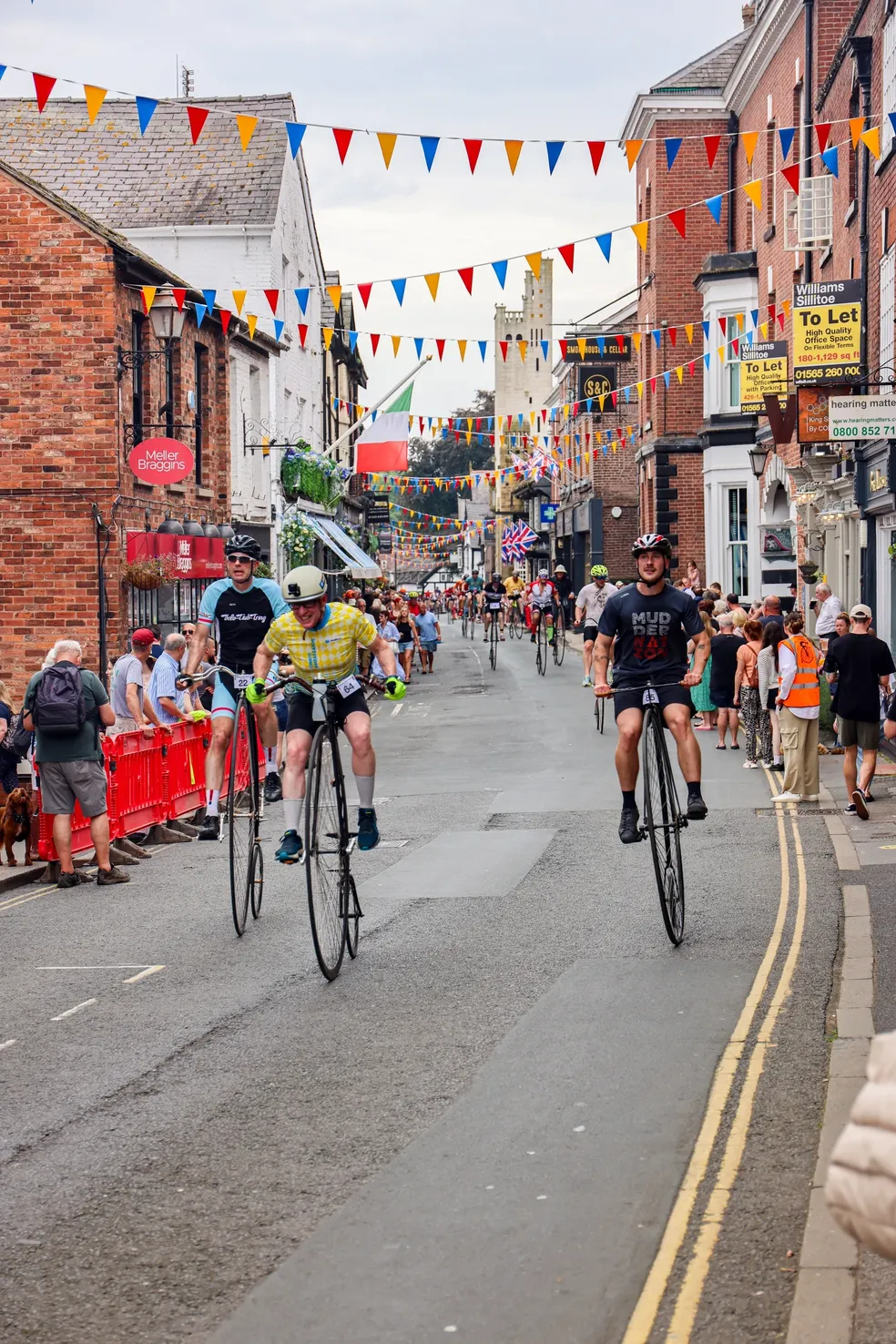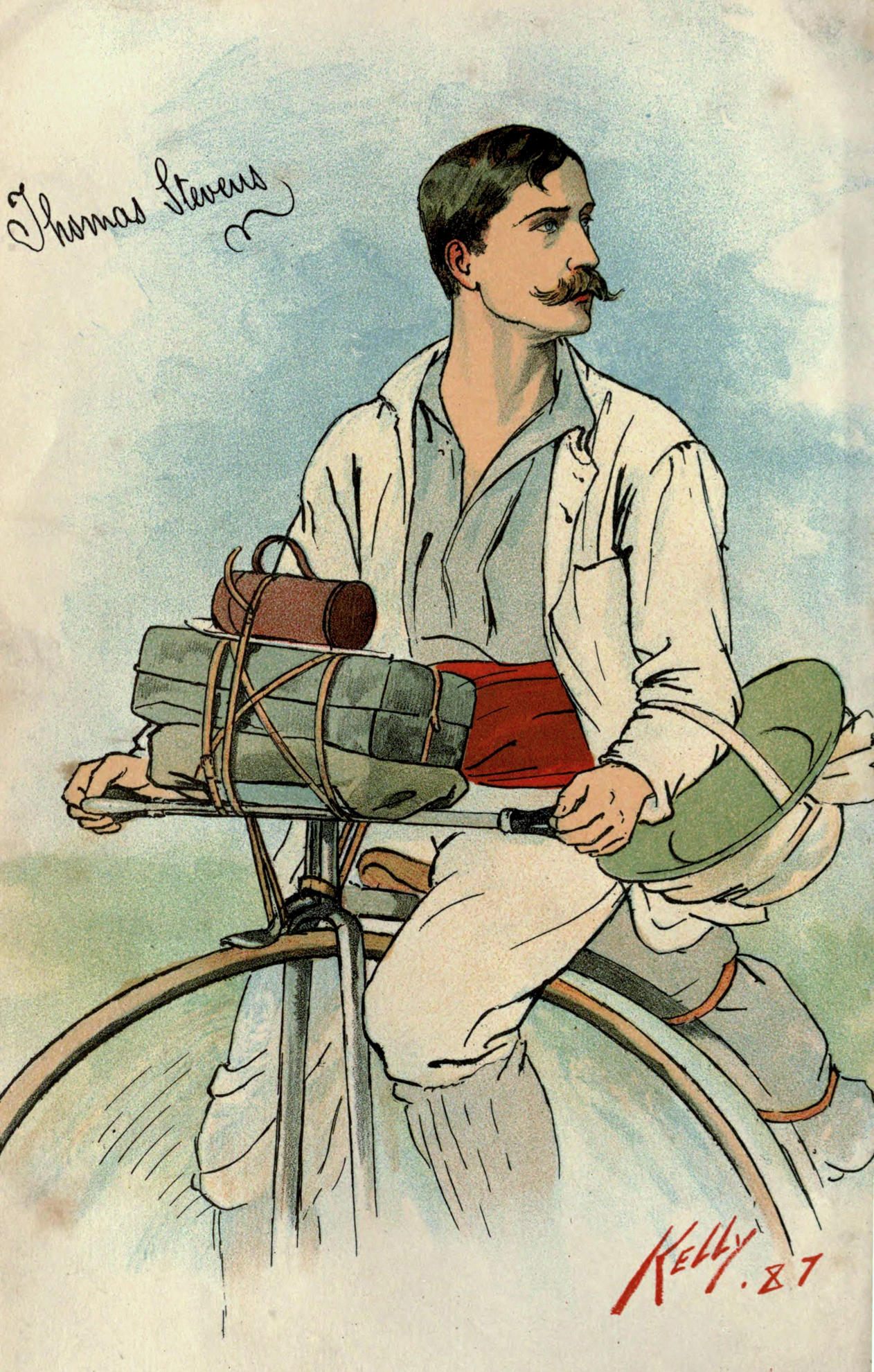The Quirky Victorian Invention That Inspired a Risky Race
Competitors battle it out from seven feet in the air.
“It’s a combination of flying a helicopter and riding a mechanical horse,” says Melissa Eisdell. She’s getting ready to mount a penny farthing, a Victorian-era bicycle with an enormous front wheel almost as tall as the rider, a tiny back tire, and a saddle that sits typically five feet off the ground. Eisdell is the current European Female Penny Farthing Racing Champion, and held the UK title for a year. Now, she’s participating in The Knutsford Great Race 2023, in a leafy corner of northwest England.
The Great Race is normally held every ten years in this sleepy Cheshire town, but the pandemic pause means it’s been 13 years since the last one. The air in Knutsford is filled with anticipation from spectators undeterred by gathering clouds, because it’s time for this one-of-a-kind competition.
After completing a warm-up lap of the circuit, Eisdell stands with the riders behind their bikes, gripping the handle bars and placing one foot on the lower step just above the rear wheel. When the green flag is waved, they briefly scoot behind their contraptions before leaping up high to mount their tall machines. The effect is like watching fledglings take flight—a few hops, a couple jumps, and they’re all off, feet pedaling furiously as each enormous front wheel moves forward.

They quickly begin to roll, picking up speed around a clockwise circuit that stretches a little over half a mile. For the next three hours, they’ll circle this course, which features a gentle rise, a small descent, and a few twists and turns along the way. “You’re using your weight to deal with the terrain; if it changes, you might lean forwards somewhat, you might lean back,” says Eisdell.
The event bills itself as “a test of skill, endurance, and perhaps most of all, bravery.” In fact, riding penny farthings is more dangerous than you might initially think. “It’s avant-garde, it’s risky,” says Eisdell, who grew up riding horses. “When you’re riding a penny farthing, you have to think 10 or 20 steps ahead compared to riding a bike or a horse, because there are no brakes, there are no gears, and you are seven feet up. One jerk can mean the bike flips and that’s you, hurtling through the air.”
Indeed, whilst some bikes have a brake fitted to the rear wheel, bikes like Melissa’s have none at all. To stop, you have to pedal slower until you intuitively know when to jump off.

Unlike modern bicycles, where a chain connects the pedals to the back wheel so that it turns easily, penny farthings are “direct drive,” meaning they have pedals attached to the center of the large front wheel. “You have to constantly use your legs like the engine, but [they’re] also used like a braking system,” Eisdell explains. “You have to judge 360 what’s going on around you. That’s why I say it’s a bit like flying a helicopter, because you have to have this really weird peripheral vision at the same time as riding the bike.”
It’s the sort of thing that attracts competitors like Neil Laughton, whose recent book, Adventureholic, aptly encapsulates his character. Laughton’s intrepid spirit became apparent when he set off on a canoeing expedition at the age of 13. Since then he has participated in several Everest expeditions and is one of the select few to hold the Explorers Grand Slam.

Laughton also invented penny farthing polo. Upon reading they were coming back into fashion, he says, “My first thought was, ‘Wow, penny farthings, I wonder if I could ride them?’ And my second thought was… ‘I wonder if you can play penny farthing polo?’ Being a man of action I imported eight bikes (four-a-side) for polo.”
Laughton holds three world records for riding a penny farthing with no hands: the fastest speed (18.39 miles per hour), the fastest 10k (23 minutes and 23.74 seconds), and the furthest distance in 1 hour (16.15 miles). It’s a skill he shows off at the 2023 Great Race, the crowd cheering each time he lets go of his handlebars and flaps his outstretched arms, his apparent ease belying the mastery involved. And he does all this while wearing a button-up shirt, tie, and suit coat tails.
Participants like Eisdell and Laughton are battling it out for the coveted Stockdale Trophy, presented to the rider completing the fastest lap. After much turmoil and sweat, awards are given to riders for the fastest single lap, fastest solo female, fastest solo male, fastest team, and even the best dressed.

In fact, race attire is part of what makes the event so peculiar and arresting. Whilst some are in Lycra, many have embraced the vintage look of their machines. There’s a muscled Victorian strongman sporting a red tank top and twirled mustache, a couple of steampunks in top hats and goggles, while another person wears a striped shirt with suspenders and a pith helmet. Plus-fours are in abundance, and there’s the occasional flash of a glittery waistcoat.
The bikes themselves also vary; some are renovated bona fide Victorian models, others are modern-day replicas, and yet others are contemporary versions made with modern-day manufacturing techniques and materials. At once elegant yet comical, the historical oddity is now experiencing a revival.
Glynn Stockdale started The Great Race in 1980, when he and a friend both purchased penny farthings and decided to race against each other. “It was a big effort for just the two of us to go head-to-head,” says Stockdale, so they decided to invite other participants from penny farthing clubs across the country. The event ended up attracting 72 competitors and became a fundraiser to support Cancer Research UK and the National Society for the Prevention of Cruelty to Children. The subsequent 1990 race garnered 50 competitors, and this year, 111 people participated. The event is so popular that 2023’s Great Race includes competitors from continental Europe, the U.S., and New Zealand.

You could say Stockdale also drew much inspiration from Thomas Stevens, who, in 1884, rode 3,700 miles over three months across the U.S., from San Francisco to Boston, all on a penny farthing. Stockdale recreated the journey in 1995, at age 57, and became the only Englishman to cross the States on a penny farthing in the twentieth century. He faithfully followed Stevens’s route, taking 45 days on a vintage 1884 machine. “On the worst day,” he says, “it took me three hours to do nine miles against the wind. On a good day… you could go 126 miles alongside the Salt Lake [in] Utah.”
Stockdale collected 80 of the highest-quality penny farthings by 2022, gathering them from salerooms throughout the UK. But one of those bikes in particular carried the Great Race legacy onward, thanks to Mike Peacock.
Peacock stumbled across the Great Race in 2010. After expressing an interest, his wife responded by buying him one, which came with what Peacock calls “a gentleman’s agreement: a shake of the hand” from its previous owner. That prior owner happened to be Stockdale. The race founder handed over the penny farthing on the condition Peacock organize the next race.
Today, Peacock is proud of having put the 2023 Great Race together. He is dressed in a red and yellow MCC cricket cap, tweed waistcoat, and checkered plus-fours, and is here more for enjoyment than speed, riding a few leisurely laps rather than the full three hours. “You’ve got to be quite eccentric to ride these things,” he laughs. “The essence of the event is… a little bit mad, a little bit bonkers, a little bit eccentric, a little bit dangerous. But it’s all quite carefully planned.” Still, as Peacock says, “It’s that element of danger and risk that draws people.”

That danger is something Eisdell can attest to. At 2 hours 56 minutes, in 10th position and with about a lap and a half to go, another rider collides with her in an impact she likens “to being in the ejector seat of a fighter plane.”
After being launched vertically, Eisdell says she landed on a water bottle—which saved her from breaking her shoulder or collarbone. She bruised her elbow and two ribs, and her head and knees smashed into the ground, leaving her in searing pain and unable to speak for at least 15 minutes. She is amazed to have escaped without serious injury. However, due to her prowess prior to the accident, she still takes first place for the women’s race and 11th place overall.
Laughton’s race is less eventful—he suspects he finished somewhere in the middle, but his electronic tracking tag malfunctioned during the event, so he doesn’t have the stats. Still, he’s not deterred. He’s quickly moving on to the next penny farthing adventure: embarking on a 400-mile fundraising mission in eastern Europe in aid of Siobhan’s Trust, which distributes food to those in need. He says with a smile: “Lookout for a video of an Englishman riding a penny farthing across Ukraine.”













Follow us on Twitter to get the latest on the world's hidden wonders.
Like us on Facebook to get the latest on the world's hidden wonders.
Follow us on Twitter Like us on Facebook